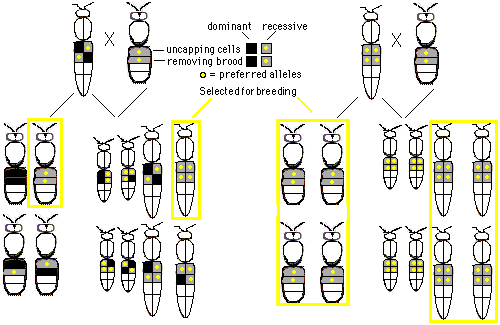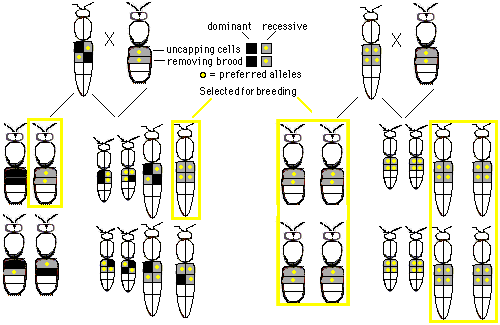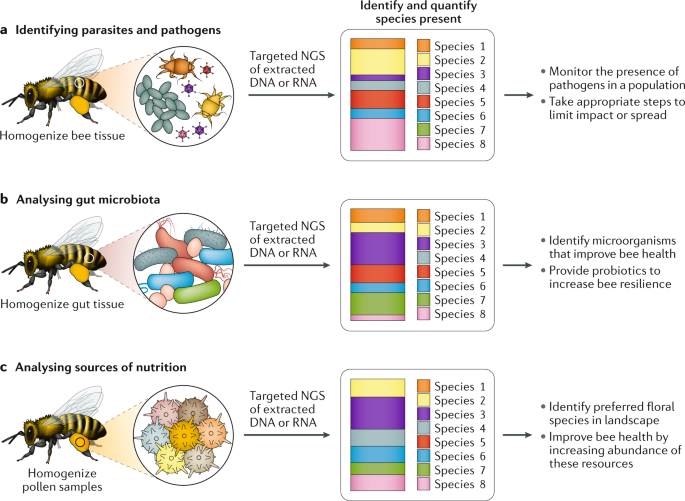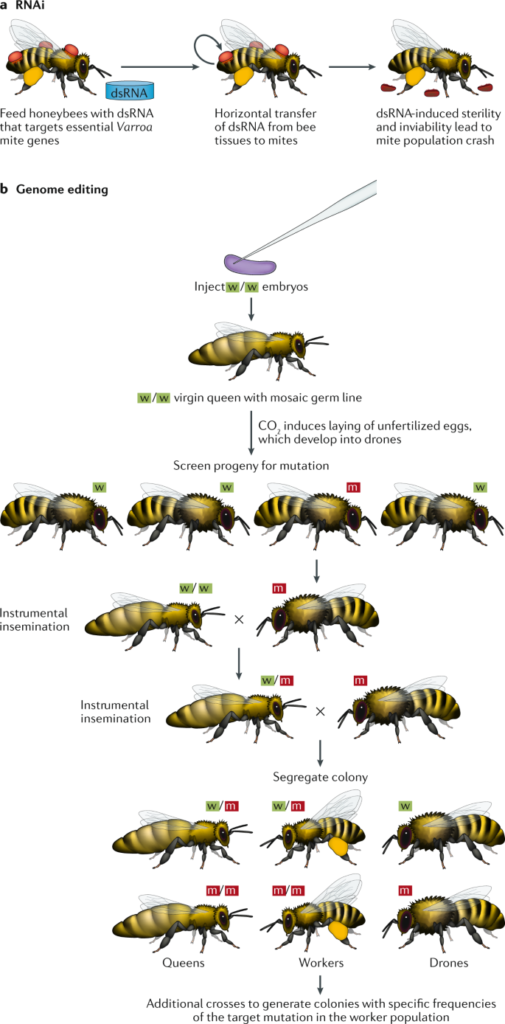
In “Mastering Bee Genetics: Breeding for Health, Honey, and Harmony!”, you will discover the fascinating world of bee genetics and the incredible benefits that come from careful breeding. Learn how scientists and beekeepers work together to improve the health and productivity of honeybees while promoting harmony within the hive. From selecting the best traits to understanding the complex interactions of genes, this article will take you on a intriguing journey into the intricate world of bee genetics. So, get ready to unlock the secrets of bee breeding and witness the magic of nature at work!

1. The Importance of Bee Genetics
Bees play a crucial role in our ecosystems as pollinators, and understanding their genetics is essential for their survival and overall health. Genetic diversity in bees is vital for their ability to adapt to environmental changes, combat diseases, and maintain thriving populations. By studying bee genetics, we can unlock valuable insights into their behavior, social organization, and honey production.
1.1 Understanding Genetic Diversity in Bees
Genetic diversity refers to the variety of genes within a population. In bees, genetic diversity plays a critical role in their resilience and ability to withstand environmental challenges. Bees with a high level of genetic diversity are better equipped to adapt to changes in their habitat, resist diseases, and cope with climate fluctuations. Without sufficient genetic diversity, bee populations become more susceptible to diseases and face a greater risk of extinction.
1.2 The Impact of Genetics on Bee Health
The genetic makeup of bees influences their overall health and susceptibility to diseases. Certain genetic factors can make bees more resistant or susceptible to common diseases, such as varroa mites and bacterial infections. By understanding the genetic markers for disease resistance, beekeepers can selectively breed bees with enhanced resilience, helping to safeguard their health and ensuring the long-term survival of bee populations.
1.3 Genetic Factors Affecting Honey Production
Honey production is a key economic aspect of beekeeping, and genetics play a significant role in determining a colony’s honey production potential. Different bee strains and genetic variations can impact honey productivity, with some bees naturally producing larger quantities of honey or producing honey with specific qualities, such as flavor or color. By selectively breeding bees with desirable honey production traits, beekeepers can optimize their productivity and meet market demands.
1.4 The Role of Genetics in Bee Behavior and Social Harmony
Genetics also influence bee behavior and social dynamics within a colony. Certain genetic factors contribute to the coordination, communication, and organization within a hive. Bees with genetic predispositions for efficient hive communication and harmonious social interactions are essential for the overall success and productivity of a colony. Understanding these genetic factors can help beekeepers breed bees with desirable behavioral traits, creating calmer and more productive colonies.
2. An Overview of Bee Breeding
Bee breeding is a valuable tool for harnessing and utilizing desirable genetic traits in bee populations. Through selective breeding and the application of appropriate tools and techniques, beekeepers can enhance desired traits, such as disease resistance, honey production, and behavioral characteristics.
2.1 Selective Breeding: Its History and Purpose
Selective breeding, also known as artificial selection, is a long-standing practice in beekeeping. The goal of selective breeding is to choose and mate bees with desirable characteristics to produce offspring with those same traits. Beekeepers have selectively bred bees for centuries to optimize honey production, improve disease resistance, and enhance other beneficial traits. This practice has shaped various bee strains and contributed to the development of distinct bee populations worldwide.
2.2 Traits to Consider in Bee Breeding
When breeding bees, it is crucial to consider specific traits that align with the desired outcomes. These traits may include disease resistance, honey production, temperament, foraging behavior, and overwintering capabilities. By identifying and prioritizing these traits, beekeepers can make informed decisions when selecting and breeding bees to achieve their desired results.
2.3 Tools and Techniques for Genetic Evaluation
Modern advancements in genetic evaluation techniques have revolutionized bee breeding practices. DNA analysis, such as polymerase chain reaction (PCR) and next-generation sequencing, allows beekeepers to evaluate the genetic diversity and relatedness of individuals within a population. Genetic evaluation provides valuable information that helps guide breeding decisions, identify desirable traits, and ensure the preservation of genetic diversity in bee populations.
2.4 Challenges in Bee Breeding
Bee breeding is not without challenges. Maintaining genetic diversity while selectively breeding for specific traits requires careful management and monitoring. Inbreeding, which occurs when closely related individuals mate, can lead to reduced genetic diversity and the expression of harmful recessive traits. Balancing the need for specific traits with the preservation of genetic health poses a challenge for bee breeders. Additionally, breeding selection must also consider environmental factors and regional variations in order to produce bees that thrive in specific locations and conditions.
3. Maintaining Genetic Health in Bee Populations
Genetic health is crucial for ensuring the long-term survival and resilience of bee populations. Maintaining genetic health involves addressing genetic diseases and disorders, implementing techniques for disease resistance, restoring genetic diversity, and monitoring genetic factors.
3.1 Genetic Diseases and Disorders in Bees
Bees, like any other living organism, can be susceptible to genetic diseases and disorders. Some diseases arise from genetic mutations, while others may be the result of environmental factors interacting with genetic predispositions. Common genetic disorders in bees include wing deformities, developmental abnormalities, and immune system deficiencies. By understanding and identifying genetic diseases, beekeepers can take appropriate measures to manage and minimize their impact on bee populations.
3.2 Queen Rearing Techniques for Disease Resistance
Queens are the backbone of bee colonies and have a significant influence on the genetic makeup of subsequent generations. Rearing queens with a focus on disease resistance is essential for maintaining genetic health in bee populations. Beekeepers can utilize selective breeding techniques to raise queen bees that have genetic traits associated with resistance to common diseases. This approach enhances the overall health and vitality of the colony and improves the chances of survival in challenging environments.
3.3 Genetic Diversity Restoration Strategies
Genetic diversity restoration is crucial for maintaining healthy and resilient bee populations. Beekeepers can actively promote genetic diversity through a variety of strategies, such as introducing new genetic material through controlled crossbreeding or introducing bees from different geographic regions. By incorporating genetic diversity restoration into their breeding programs, beekeepers help minimize the risks associated with reduced genetic diversity and increase the overall adaptability of their bee populations.
3.4 Importance of Genetic Testing and Monitoring
Regular genetic testing and monitoring are vital components of maintaining genetic health in bee populations. Genetic testing allows beekeepers to identify and track specific genetic traits, disease resistance markers, and genetic variations within their colonies. Monitoring genetic changes over time helps beekeepers assess the success of their breeding programs and make informed decisions for future breeding strategies. Genetic testing and monitoring enable proactive management and breeding decisions to ensure the long-term genetic health and stability of bee populations.
4. Breeding for Increased Honey Production
Honey production is a significant aspect of beekeeping, and by understanding the genetic factors influencing honey quantity and quality, beekeepers can selectively breed bees for increased honey production.
4.1 Genetic Factors Influencing Honey Quantity and Quality
The genetics of honeybees directly influence their ability to produce honey. Certain genetic variations and traits can enhance honey production, including the amount of nectar collected, the efficiency of nectar processing, and honey storage capabilities. By selectively breeding bees with these desirable genetic traits, beekeepers can increase honey production in their colonies and meet the demands of the honey market.
4.2 Selecting Bees with High Nectar Collection Traits
Nectar collection is a fundamental behavior for honeybees, and genetic variations impact their capabilities in this area. Some bees naturally excel at locating, collecting, and transporting nectar, leading to increased honey production. Beekeepers can select bees with high nectar collection traits by observing their foraging behavior and gathering data on their nectar collection efficiency. By breeding bees with these desirable traits, beekeepers can develop colonies with enhanced nectar collection abilities and ultimately increase honey production.
4.3 Improving Honey Production Through Genetic Manipulation
Advancements in genetic manipulation techniques offer exciting possibilities for improving honey production in bees. Genetic engineering allows scientists to introduce specific genes into honeybee populations to enhance certain characteristics, such as increased honey production or improved resistance to diseases. While genetic manipulation holds promise, ethical considerations and environmental impacts must be thoroughly assessed before implementing these techniques on a larger scale. The potential benefits of genetic manipulation in honey production must be weighed against potential risks and concerns.
4.4 The Role of Nutrition in Honey Production
Genetics alone are not the sole determinants of honey production; nutrition also plays a significant role. Bees require a well-balanced diet to produce optimal amounts of honey. Adequate access to diverse and abundant floral resources ensures that bees have access to sufficient nectar and pollen, essential components for honey production. Beekeepers can both breed for desirable genetic traits and provide a diverse forage environment to support honey production in their colonies.

5. Understanding the Genetics of Bee Behavior
Bee behavior is intricately linked to their genetic makeup, and studying the genetics of behavior provides valuable insights into their communication, coordination, defense mechanisms, and overall social organization.
5.1 Genetic Basis for Hive Communication and Coordination
Hive communication and coordination are critical for the smooth operation of a bee colony. Genetic factors influence various aspects of hive communication, including the famous waggle dance, which conveys information about nectar sources to other bees. The ability to communicate and coordinate effectively within a colony contributes to its efficiency and productivity. Understanding the genetic basis of these behaviors opens avenues for selectively breeding bees with enhanced communication and coordination abilities, leading to more productive and successful colonies.
5.2 Genetic Factors Affecting Defense and Propolis Production
Bees have intricate defense mechanisms to protect their colonies from predators, pests, and diseases. Genetic factors impact their defensive behaviors, including recognizing intruders, aggression levels, and production of propolis—a resinous substance that bees use to reinforce and seal their hive. Beekeepers can selectively breed bees with enhanced defensive traits to develop colonies that are better equipped to fend off threats and protect their overall health.
5.3 Breeding Calm and Productive Bees
Calm and productive bees are highly valued by beekeepers. Genetic factors influence temperament and behavior, determining how bees interact with beekeepers, how easily bees can be managed, and how prone they are to aggression. By selectively breeding bees with calm and gentle traits, beekeepers can create more manageable colonies and reduce the risk of unpleasant encounters. Calm bees also tend to be more productive, as they allocate more energy towards foraging, honey production, and other beneficial activities.
5.4 Social Organization and Genetic Influences
The social organization within a bee colony is a complex phenomenon, influenced by various genetic factors. The division of labor, spatial organization, and caste system within a colony are directly linked to the genetic makeup of individual bees. Certain genetic variations contribute to the development of different castes, such as workers, queens, and drones. Understanding the genetic influences on social organization provides invaluable knowledge for beekeepers who seek to optimize colony productivity, health, and overall well-being.
6. Ethical Considerations in Bee Breeding
While bee breeding offers numerous benefits, ethical considerations must guide breeding practices to ensure the preservation of native bee species, balance individual and collective benefits, avoid negative genetic consequences, and carefully assess the implications of genetic modification.
6.1 Maintaining Genetic Integrity of Native Bee Species
Bee breeders have a responsibility to maintain the genetic integrity of native bee species. Biodiversity and the preservation of unique genetic adaptations within certain bee populations are crucial for ecosystem health and resilience. When breeding bees, it is important to prevent the unintentional hybridization of native species with introduced or managed populations. Careful monitoring and separation of bee colonies can help maintain the genetic integrity of native bee species and protect their distinct traits and adaptations.
6.2 Balancing Individual and Collective Benefits
In bee breeding, there is a delicate balance between selecting for individual benefits, such as honey production or disease resistance, and maintaining the overall health and functionality of the colony. While it may be tempting to prioritize specific traits for certain individual colonies, it is crucial to consider the collective benefits and long-term sustainability of the entire bee population. Breeding decisions should take into account the broader context of the ecosystem and the needs of the entire community of bees.
6.3 Avoiding Negative Genetic Consequences
Intensive selective breeding practices can inadvertently lead to negative genetic consequences if not managed carefully. Inbreeding, the loss of genetic diversity, and the expression of harmful recessive traits are potential risks associated with improper breeding practices. Bee breeders must be vigilant in their selection processes to prevent these negative genetic consequences. Regular genetic evaluation, monitoring, and outcrossing with genetically diverse populations are essential strategies for maintaining healthy and genetically robust bee populations.
6.4 Implications of Genetic Modification in Bees
Genetic modification, also known as genetic engineering, allows for the deliberate insertion or alteration of specific genes within an organism’s genetic makeup. While this technology offers potential benefits in bee breeding, such as disease resistance or enhanced honey production, it also raises ethical questions and potential risks. The long-term impacts of genetic modification on bee populations, ecosystem interactions, and unintended consequences require careful evaluation. Balancing the potential benefits against the risks and addressing ethical concerns remains critical in the responsible application of genetic modification in bees.

7. Innovative Techniques in Bee Genetics
Advancements in bee genetics research have introduced innovative techniques to understand and manipulate bee genetics. Molecular markers, genome mapping, DNA sequencing, genetic alteration, and gene editing have all contributed to expanding our knowledge and capabilities in bee breeding.
7.1 Molecular Markers for Genetic Identification
Molecular markers are specific regions of DNA that can be used to identify individual bees and assess genetic relatedness. These markers allow for accurate identification of individuals within a population and provide insights into their genetic diversity and relationships. By using molecular markers, researchers and beekeepers can better understand the genetic structure and relatedness of bee populations, guiding breeding decisions and conservation efforts.
7.2 Genome Mapping and DNA Sequencing
Genome mapping and DNA sequencing techniques have revolutionized bee genetics research. These techniques allow scientists to decipher the precise order of DNA bases in bee genomes, providing important information about the genetic code of bees. Genome mapping and DNA sequencing facilitate the identification of genes associated with specific traits, disease resistance markers, and patterns of genetic variation. This knowledge empowers bee breeders to make informed decisions, develop targeted breeding programs, and better understand the genetic underpinnings of bee biology.
7.3 Genetic Alteration and Gene Editing
The emergence of genetic alteration techniques, such as gene editing, opens up new possibilities for manipulating bee genetics. Gene editing technologies like CRISPR-Cas9 enable scientists to make targeted modifications within the genome, such as introducing desired genes or deleting specific genetic sequences. While still in its early stages in bee genetics research, gene editing holds promise for developing disease-resistant bees, enhancing honey production traits, and addressing pressing challenges in beekeeping. However, the ethical implications, regulatory frameworks, and environmental impacts of genetic alteration must be carefully considered and addressed.
7.4 Transferring Desirable Traits Across Bee Species
Knowledge gained through bee genetics research allows for the transfer of desirable traits across different bee species. When genetic similarities between species are identified, beekeepers can selectively breed bees from different species to introduce beneficial traits into other populations. This transfer of traits contributes to the overall adaptability and genetic robustness of bee populations, enhancing their ability to thrive in diverse environments and face future challenges.
8. Adaptation to Environmental Challenges
Bees face numerous environmental challenges, including climate change, pesticide exposure, and the impact of varroa mites. Understanding the genetic responses to these challenges and selectively breeding bees for resilience is vital for their survival and long-term health.
8.1 Genetic Responses to Climate Change
Climate change poses significant challenges for bees, with rising temperatures, altered precipitation patterns, and habitat loss affecting their foraging capabilities and overall health. Bees with genetic variations that enable them to better adapt to changing climatic conditions have an increased likelihood of survival. Beekeepers can selectively breed bees with genetic traits associated with adaptability to help them cope with the shifting environmental conditions brought on by climate change.
8.2 Breeding Bees for Resistance to Pesticides
Pesticide exposure poses a significant risk to bee populations, impacting their health and ability to survive. However, some bees exhibit genetic traits that confer resistance or tolerance to certain pesticides. By selectively breeding bees with these resistance traits, beekeepers can develop colonies that are better equipped to withstand pesticide exposure and minimize the negative effects on their populations. Breeding for pesticide resistance can help ensure the long-term health and survival of bee populations in pesticide-intensive agricultural landscapes.
8.3 Genetics and Varroa Mite Control
Varroa mites are one of the most significant pests affecting bee populations worldwide, causing colony losses and compromising bee health. Genetic factors influence the susceptibility or resistance of bees to varroa mite infestations. Bee breeders can selectively breed bees with genetic traits associated with varroa mite resistance, such as grooming behavior or hygienic traits that actively remove mites from infested cells. Breeding for varroa mite resistance is a crucial strategy for mitigating the impact of these pests on bee populations.
8.4 Enhancing Bee Adaptability through Selective Breeding
Selective breeding provides beekeepers with the tools to enhance the adaptability of bees to a changing environment. By identifying and selecting bees with genetic traits associated with adaptability, such as the ability to thrive in diverse foraging ecosystems or resist emerging diseases, beekeepers can develop colonies that are better suited to withstand environmental challenges. Adaptive breeding programs contribute to the long-term resilience and health of bee populations, ensuring their ability to thrive and fulfill their essential role as pollinators.

9. Honeybee Conservation and Genetic Preservation
Conserving honeybees and preserving their genetic diversity is vital for safeguarding their future and maintaining healthy and robust bee populations. Genetic banks and cryopreservation techniques play a crucial role in these conservation efforts.
9.1 Maintaining Genetic Diversity in Bee Populations
Genetic diversity is essential for the long-term survival and adaptability of bee populations. Conserving genetic diversity involves preserving distinct bee strains, maintaining genetic variation within populations, and protecting the vital adaptations that allow bees to thrive in different environments. By promoting the conservation of genetic diversity, beekeepers and researchers contribute to the preservation of healthy and resilient bee populations.
9.2 Protecting Native Bee Species through Breeding
Native bee species, with their unique genetic adaptations, play a crucial role in ecosystem functioning and stability. Preserving native species through breeding programs ensures the preservation of valuable genetic material that may provide resilience and adaptability to future challenges. By selectively breeding native bee species, beekeepers can contribute to the conservation of biodiversity, support ecosystem health, and maintain the natural balance of pollination services.
9.3 Genetic Banks and Cryopreservation Techniques
Genetic banks and cryopreservation techniques provide a means of preserving the genetic material of honeybees for future use. Genetic banks store genetic samples, such as semen or tissue samples, from valuable breeding lines or populations. Cryopreservation techniques, including freezing genetic material in liquid nitrogen, offer a means of long-term storage of genetic samples without compromising their viability. These technologies are critical tools for preserving genetic diversity and safeguarding valuable genetic material, ensuring its availability for future breeding and conservation efforts.
9.4 Collaboration for Global Bee Conservation Efforts
Global bee conservation efforts require collaboration across scientific disciplines, beekeeping communities, and governmental organizations. The preservation of bee populations and their genetic diversity necessitates coordinated research, conservation strategies, and knowledge-sharing. Collaboration facilitates the exchange of genetic material, improves breeding techniques, and enhances the collective understanding of the complex dynamics of bee genetics and conservation. By working together, stakeholders can create a robust framework for global bee conservation efforts, maximizing the chances for successful long-term preservation.
10. Future Trends in Bee Genetics
As bee genetics research continues to advance, future trends will focus on advancements in genetic research techniques, genetic selection for disease resistance, improving honeybee traits through genetic engineering, and exploring the interplay between bee genetics and ecosystem health.
10.1 Advancements in Genetic Research Techniques
Advancements in genetic research techniques are poised to revolutionize our understanding of bee genetics. Improved DNA sequencing technologies, single-cell genomics, and functional genomics will provide new insights into the genetic basis of bee traits, diseases, and behaviors. These advancements will enhance our ability to identify specific genes and genetic variations associated with beneficial traits, disease resistance, and environmental adaptation.
10.2 Genetic Selection for Disease Resistance
Disease resistance is a crucial factor for bee health and survival. Future trends in bee genetics will focus on better understanding the genetic basis of disease resistance. By identifying and selecting bees with inherent genetic traits associated with disease resistance, beekeepers can develop colonies that are naturally resistant to common diseases, reducing the need for chemical interventions. Genetic selection programs for disease resistance hold promise for improving the overall health and resilience of bee populations.
10.3 Improving Honeybee Traits through Genetic Engineering
Genetic engineering is an area of ongoing research in bee genetics. Future trends will explore the potential of genetic engineering to enhance desirable honeybee traits, such as disease resistance, nectar collection efficiency, and honey production. However, ethical considerations, regulatory frameworks, and potential ecological impacts will continue to shape the responsible use and deployment of genetic engineering in bees.
10.4 The Interplay of Bee Genetics and Ecosystem Health
Future research will delve deeper into the interplay between bee genetics and ecosystem health. Understanding the genetic basis of bee traits, behaviors, and adaptations contributes to a broader understanding of how bees interact with their environment and fulfill their crucial role as pollinators. By comprehending this intricate interplay, researchers can draw connections between bee genetics, ecosystem dynamics, and the broader implications for biodiversity conservation and ecosystem functioning.
By delving into the diverse aspects of bee genetics, from understanding genetic diversity and breeding techniques to ethical considerations and future trends, beekeepers and scientists can continue to advance our understanding of these incredible creatures and ensure their future health, honey production, and harmonious coexistence within our ecosystems.
